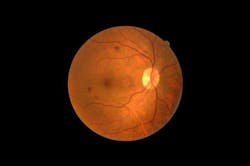Ultrathin artificial retina is based on 2D materials
Scientists at the University of Texas at Austin and Seoul National University report that they have successfully developed and tested the world's first ultrathin artificial retina that could vastly improve on existing implantable visualization technology for the blind. The flexible device, based on molecular-thickness 2D materials, could someday restore sight to the millions of people with retinal diseases. With a few modifications, the device could be used to track heart and brain activity.
The researchers presented their work today at the 256th National Meeting & Exposition of the American Chemical Society (ACS; Boston, MA; Aug. 19 to 23, 2018).
"This is the first demonstration that you can use few-layer graphene and molybdenum disulfide to successfully fabricate an artificial retina," says Nanshu Lu, of the University of Texas at Austin.
Diseases such as macular degeneration, diabetic retinopathy, and retinitis pigmentosa can damage or destroy retinal tissue, leading to vision loss or complete blindness. There is no cure for many of these diseases, but silicon-based retinal implants have restored a modicum of vision to some individuals. However, Lu says these devices are rigid, flat, and fragile, making it hard for them to replicate the natural curvature of the retina. As a result, silicon-based retinal implants often produce blurry or distorted images and can cause long-term strain or damage to surrounding eye tissue, including the optic nerve.
The researchers used 2D materials, including graphene and molybdenum disulfide, as well as thin layers of gold, alumina, and silicon nitrate to create a flexible, high-density curved sensor array. The device conforms to the size and shape of a natural retina without mechanically disturbing it.
In laboratory and animal studies, photodetectors on the device readily absorbed light and passed it through a soft external circuit board. The circuit board housed all of the electronics needed to digitally process light, stimulate the retina and acquire signals from the visual cortex. Based on these studies, the researchers determined that this prototype artificial retina is biocompatible and successfully mimics the structural features of the human eye. They say it could be an important step in the quest to develop the next generation of soft bio-electronic retinal prostheses.
Moving ahead, Lu is exploring ways to integrate this technology into mechanically and optically imperceptible electronic tattoos that are laminated on the skin surface to gather real-time health information. Lu says that the team plans to add transistors to these transparent e-tattoos to help amplify signals from the brain or the heart so they can be more easily monitored and treated. These ultrathin sensors and electrodes can also be implanted on the surface of the heart to detect arrhythmias. Lu says doctors could potentially program them to act like tiny pacemakers, sending electrical impulses through the heart to correct the problem.
About the Author
John Wallace
Senior Technical Editor (1998-2022)
John Wallace was with Laser Focus World for nearly 25 years, retiring in late June 2022. He obtained a bachelor's degree in mechanical engineering and physics at Rutgers University and a master's in optical engineering at the University of Rochester. Before becoming an editor, John worked as an engineer at RCA, Exxon, Eastman Kodak, and GCA Corporation.

